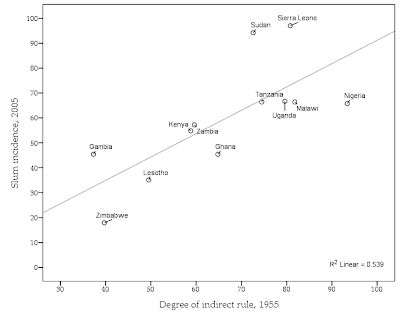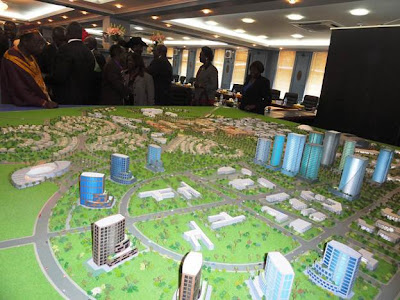This is a guest post by Sean Fox at the LSE
Popular accounts of life in African cities typically portray
a Dickensian squalor in the tropics: unkempt masses struggling with
poverty, disease and violence. While such accounts overlook the dynamic
nature of African cities and the resilience of their residents, they
do reflect an important truth. Sub-Saharan
Africa has the highest rate of ‘slum incidence’ of any major world region, with
over 60% of the region’s urban population—roughly 200 million people—living in
settlements characterized by some combination of overcrowding, tenuous dwelling
structures, and deficient access to adequate water and sanitation facilities. However,
there is wide variation in slum incidence across countries within the region (see
Table 1). Why do so many Africans live in slums, and what accounts for the wide
variation in slum incidence across countries in the region? I address these
questions in a
recently
published working paper.
Table 1 - Slum
incidence by region and for selected African countries
|
Slum population
as % of urban population
|
|
2000
|
2005
|
2010
|
Region
|
|
|
|
Developing Regions
|
39.3
|
35.7
|
32.7
|
Sub-Saharan Africa
|
65.0
|
63.0
|
61.7
|
Southern Asia
|
45.8
|
40.0
|
35.0
|
South-eastern Asia
|
39.6
|
34.2
|
31.0
|
Eastern Asia
|
37.4
|
33.0
|
28.2
|
Western Asia
|
20.6
|
25.8
|
24.6
|
Latin America & the Caribbean
|
29.2
|
25.5
|
23.5
|
Northern Africa
|
20.3
|
13.4
|
13.3
|
Selected
African countries
|
|
|
|
Ethiopia
|
88.6
|
81.8
|
|
Tanzania
|
70.1
|
66.4
|
|
Nigeria
|
69.6
|
65.8
|
|
Ghana
|
52.1
|
45.4
|
|
South Africa
|
33.2
|
28.7
|
|
Zimbabwe
|
3.3
|
17.9
|
|
Source: UN-Habitat (2008)
|
Social scientists have traditionally portrayed slums as a
natural and temporary by-product of economic modernization. But the scale and
persistence of slum settlements in developing regions in recent decades
presents a serious challenge to this notion. A variety of theories have been
advanced to account for this apparent deviation from the assumed path of
modernization. Put together they tell a fairly simple story: urban population
growth in developing regions has outpaced economic and institutional
modernization. I refer to this as the ‘disjointed modernization’ theory of
slums and test it empirically using regression analysis. In support of this
theory, I find that nearly 70% of cross-country variation in slum incidence can
be accounted for by variation in urban population growth rates, measures of
income and economic diversification and a measure of institutional quality.
However, identifying the contemporary correlates of slum
incidence does not amount to a convincing causal explanation for the scale and
diversity of the phenomenon. Why did the process of modernization become more
disjointed in some countries than others? To answer this question I trace the
origins of divergence in urban development trajectories back to the colonial
era. Generally speaking, colonisers stimulated urban population growth but laid
a poor foundation for urban economic development and effective urban governance.
But colonial experiences varied widely across countries in Africa. Where
economic and political interests were strong, towns and cities received significant
investment and institutional development; where economic and political
interests were relatively marginal, towns and cities received minimal
investment and were left with ad-hoc governance structures. I demonstrate that
this variation is correlated with contemporary slum incidence. For example,
Figure 1 below plots slum incidence against a measure of ‘British indirect
rule’—i.e. the number of court cases adjudicated by indigenous as opposed to
colonial authorities. The figure shows that slum incidence in 2005 is closely
correlated with the measure of British indirect rule (a proxy for institutional
investment) in 1955, supporting the hypothesis that the colonial era represents
a ‘critical juncture’ in the history of urban development in sub-Saharan
Africa.
Figure 1. Colonial strategies of rule and slum incidence in 2005
Having identified the colonial origins of ‘disjointed’
modernization, I turn my attention to the mechanisms of path dependency that
have served to perpetuate colonial patterns of urban investment and
institutional development. Post-colonial African governments have had anywhere between
25 and 50 years to redress the failures of their colonial forebears. Why have
they not done so? I offer two complementary explanations.
First, urban underdevelopment offers myriad opportunities
for political and economic entrepreneurs. For example, politicians and
bureaucrats often use the absence of formal property rights in urban areas to
engage in ‘land racketeering’—i.e. offering squatters on ‘public’ land
protection from eviction in return for political support or economic rents. Similarly,
the absence of water infrastructure yields very lucrative opportunities for the
private vendors who inevitably step in to fill the void. In other words, urban underdevelopment has proven very
profitable for a range of actors in African cities, resulting in the emergence
of a broad constellation of status quo interests opposed to investment and
institutional reform.
Second, an anti-urbanization bias emerged in development
discourse and practice in the late 1970s. Up to that point, towns and cities
were seen as engines of prosperity and progressive social and political spaces.
But a series of influential publications in the 1970s and 1980s portrayed
urbanites as economic parasites feeding off the surplus produced by peasants in
the countryside and exerting an undue influence in public affairs. Investing
in urban development came to be seen as anti-developmental.
As a result, governments across Africa implemented policies to restrict or
discourage rural-urban migration and promote rural development. By 2007, 78% of
African countries had policies in place to restrict migration; up from 49% in
1976. There was also a significant contraction in international development
assistance for urban development projects. As Table 2 demonstrates, World Bank
shelter lending in the region, which began in 1972, shrivelled to near
insignificance by 2005.
Table 2. Trends in World Bank shelter lending in sub-Saharan Africa,
1971-2005
|
1972-1981
|
1982-1991
|
1992-2005
|
Total
shelter lending
|
$498 million
|
$409 million
|
$81 million
|
Equivalent
per capita
|
$5.20
|
$2.74
|
$0.32
|
Notes: Shelter lending data from Buckley and Kalarickal (2006); per capita
estimates based on total urban population in sub-Saharan Africa at the end of
each period (i.e. 1981, 1991 and 2005) drawn from World Bank, World
Development Indicators online database, accessed September 2012.
|
The proliferation of slums in sub-Saharan Africa in recent
decades is de facto evidence of government failure to invest in urban
development. But history is not destiny. As Africa’s urban population continues
to grow, politicians are increasingly likely to find it in their inteest to
address the basic needs of urban residents. And if they are committed to
stimulating economic growth and diversification they will need to do so. Cities
can serve as engines of economic development, but only if they have adequate
infrastructure and their residents have safe, healthy and secure places to
live. The international community could help facilitate this transformation by
recognizing the urban potential and supporting (as opposed to discouraging)
efforts to invest in urban development in the region.
-----
Fox, S. (2013) ‘The political economy of slums: Theory and
evidence from sub-Saharan Africa’,
Working paper series 2013, No. 13-146, Department of International Development,
London School of Economics and Political Science.



